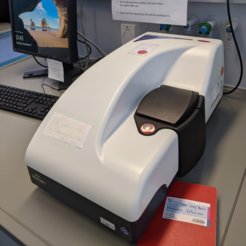
Z-Potential Analyzer

Zeta potential (ζ) of a particle or colloidal suspension is the charge that develops at the interface between a solid surface and its liquid medium and it depends on the types and concentration of ions in the media. ζ of particles is determined by measuring their velocity while they are moving due to electrophoresis. The method used is known as doppler electrophoresis. The particles in a solvent of known refractive index, velocity and dielectric constant are irradiated with a laser of wavelength λ. Upon the application of electric field of strength, the particles start moving, which will lead to the scattering of the laser light. The scattering angle (θ) is measured and the particle velocity is determined from the frequency shift. Mobility and then ζ is calculated using the Smulochowski or Henry equation.
Typical measurements:
Only liquids (aqueous solution and organic solvents possible): 0.8-0.9 mL.
Equipment
Malvern Zetasizer Nano Z
References:
[1] Phil. Trans. R. Soc. A (2010) 368, 4439–4451 doi:10.1098/rsta.2010.0175
[2] Clogston J.D., Patri A.K. (2011) Zeta Potential Measurement. In: McNeil S. (eds) Characterization of Nanoparticles Intended for Drug Delivery. Methods in Molecular Biology (Methods and Protocols), vol 697. Humana Press. https://doi.org/10.1007/978-1-60327-198-1_6
[3] Hunter, Robert J. Zeta potential in colloid science: principles and applications. Vol. 2. Academic press, 2013.
[4] Xu, Renliang. "Electrophoretic light scattering: Zeta potential measurement." Particle characterization: Light scattering methods (2002): 289-343.
Contact:
Dr. Sharafudheen Chali ( 06131-379-723)
Dr. Lucas Caire da Silva ( 06131-379-581)
